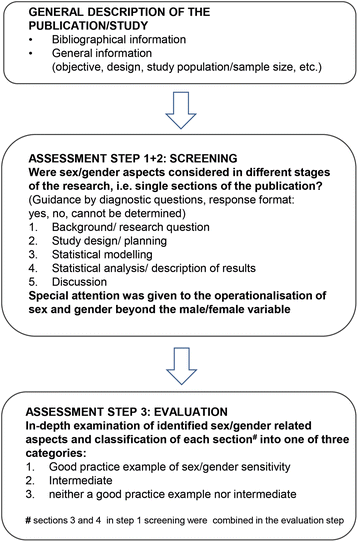Examples of sex/gender sensitivity in epidemiological research: results of an evaluation of original articles published in JECH 2006-2014
- PMID: 28202078
- PMCID: PMC5312447
- DOI: 10.1186/s12961-017-0174-z
Examples of sex/gender sensitivity in epidemiological research: results of an evaluation of original articles published in JECH 2006-2014
Abstract
Background: During the last decades, sex and gender biases have been identified in various areas of biomedical and public health research, leading to compromised validity of research findings. As a response, methodological requirements were developed but these are rarely translated into research practice. The aim of this study is to provide good practice examples of sex/gender sensitive health research.
Methods: We conducted a systematic search of research articles published in JECH between 2006 and 2014. An instrument was constructed to evaluate sex/gender sensitivity in four stages of the research process (background, study design, statistical analysis, discussion).
Results: In total, 37 articles covering diverse topics were included. Thereof, 22 were evaluated as good practice example in at least one stage; two articles achieved highest ratings across all stages. Good examples of the background referred to available knowledge on sex/gender differences and sex/gender informed theoretical frameworks. Related to the study design, good examples calculated sample sizes to be able to detect sex/gender differences, selected sex/gender sensitive outcome/exposure indicators, or chose different cut-off values for male and female participants. Good examples of statistical analyses used interaction terms with sex/gender or different shapes of the estimated relationship for men and women. Examples of good discussions interpreted their findings related to social and biological explanatory models or questioned the statistical methods used to detect sex/gender differences.
Conclusions: The identified good practice examples may inspire researchers to critically reflect on the relevance of sex/gender issues of their studies and help them to translate methodological recommendations of sex/gender sensitivity into research practice.
Keywords: Epidemiological methods; Good practice example; Sex/gender-based analysis.
Figures
Similar articles
-
[Gender-sensitive epidemiological data analysis: methodological aspects and empirical outcomes. Illustrated by a health reporting example].Bundesgesundheitsblatt Gesundheitsforschung Gesundheitsschutz. 2008 Jan;51(1):13-27. doi: 10.1007/s00103-008-0415-y. Bundesgesundheitsblatt Gesundheitsforschung Gesundheitsschutz. 2008. PMID: 18185965 German.
-
Intersectionality-based quantitative health research and sex/gender sensitivity: a scoping review.Int J Equity Health. 2019 Dec 21;18(1):199. doi: 10.1186/s12939-019-1098-8. Int J Equity Health. 2019. PMID: 31864366 Free PMC article.
-
Beyond the black stump: rapid reviews of health research issues affecting regional, rural and remote Australia.Med J Aust. 2020 Dec;213 Suppl 11:S3-S32.e1. doi: 10.5694/mja2.50881. Med J Aust. 2020. PMID: 33314144
-
Scientific excellence in applying sex- and gender-sensitive methods in biomedical and health research.J Womens Health (Larchmt). 2010 Feb;19(2):313-21. doi: 10.1089/jwh.2008.1156. J Womens Health (Larchmt). 2010. PMID: 20136550
-
Inclusion of Sex and Gender in Emergency Medicine Research-A 2018 Update.Acad Emerg Med. 2019 Mar;26(3):293-302. doi: 10.1111/acem.13688. Epub 2019 Feb 5. Acad Emerg Med. 2019. PMID: 30637897 Review.
Cited by
-
Bridging research integrity and global health epidemiology (BRIDGE) guidelines: explanation and elaboration.BMJ Glob Health. 2020 Oct;5(10):e003237. doi: 10.1136/bmjgh-2020-003237. BMJ Glob Health. 2020. PMID: 33115860 Free PMC article. Review.
-
Guidance relevant to the reporting of health equity in observational research: a scoping review protocol.BMJ Open. 2022 May 19;12(5):e056875. doi: 10.1136/bmjopen-2021-056875. BMJ Open. 2022. PMID: 35589369 Free PMC article.
-
Women experiencing homelessness and mental illness in a Housing First multi-site trial: Looking beyond housing to social outcomes and well-being.PLoS One. 2023 Feb 10;18(2):e0277074. doi: 10.1371/journal.pone.0277074. eCollection 2023. PLoS One. 2023. PMID: 36763583 Free PMC article. Clinical Trial.
-
A tool for assessing sex/gender bias in epidemiological studies of occupational health: Pilot testing on studies of sedentary behaviour at the workplace and cardiometabolic health.PLoS One. 2025 May 29;20(5):e0324391. doi: 10.1371/journal.pone.0324391. eCollection 2025. PLoS One. 2025. PMID: 40440418 Free PMC article.
-
Measurement of gender as a social determinant of health in epidemiology-A scoping review.PLoS One. 2021 Nov 3;16(11):e0259223. doi: 10.1371/journal.pone.0259223. eCollection 2021. PLoS One. 2021. PMID: 34731177 Free PMC article.
References
-
- Stephenson P, McKee M. Look twice. Eur J Public Health. 1993;3:151–152. doi: 10.1093/eurpub/3.3.151. - DOI
Publication types
MeSH terms
LinkOut - more resources
Full Text Sources
Other Literature Sources
Research Materials


